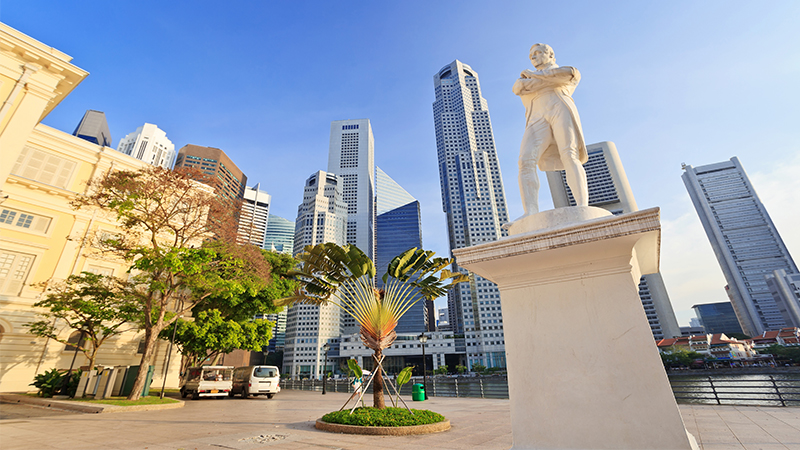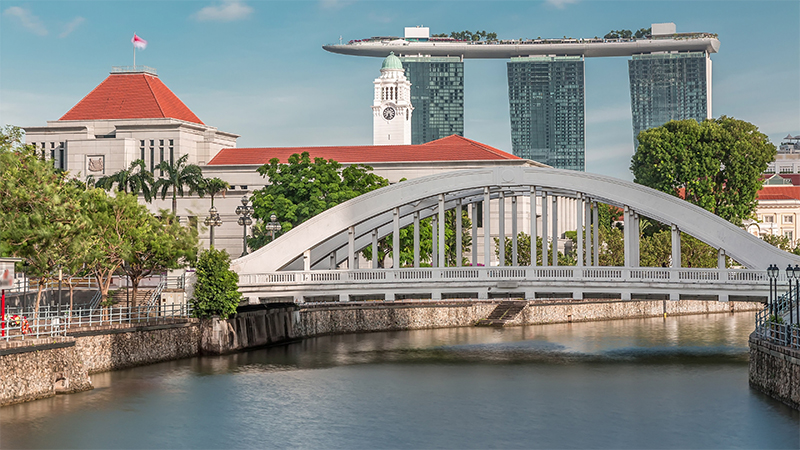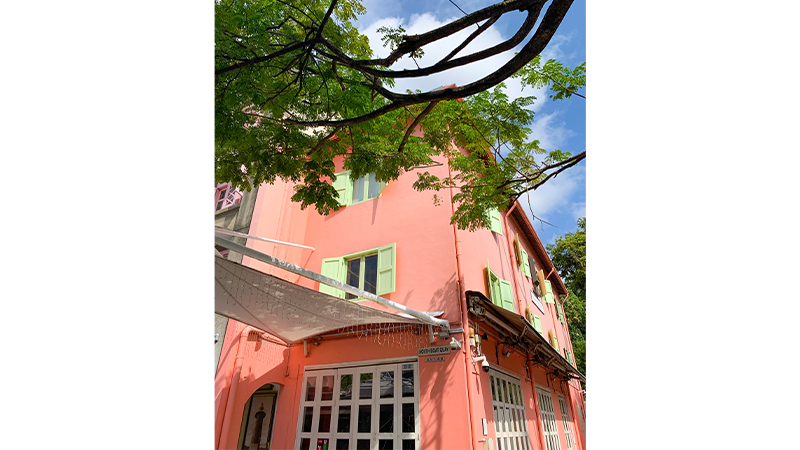In her previous contribution in Expat Living, CERI POWELL took us on a guided tour of Fort Canning Park. Here, she outlines some of the key historical statues, bridges and buildings you can see on a walk beside the Singapore River.
The Singapore River has been the lifeblood of the island for more than 600 years. This short river walk along the banks, criss-crossing ornate bridges, gives a sense of history while also unearthing some unexpected modern twists. The 2.5km river walk takes approximately 50 minutes with frequent pauses to soak in the views.

Singapore River Walk
Location #1
We start the river walk from Raffles Place MRT (Exit G) along Bonham Street. Turning right towards the Fullerton Hotel, we pass the bronze sculpture scene, River Merchants. The seated European is Alexander Laurie Johnston; he was one of the earliest traders, whose “go-down” was at this very spot in 1820. The declaring of Singapore as a tax-free port, unique in Asia, kick-started commerce with junks and lighters arriving to trade silk, porcelain, coffee and opium. The shipping trade was especially intense in December; that’s when Chinese ships arrived on the monsoon wind, staying until the wind changed the following June.
Location #2
Cavenagh Bridge, completed in 1869, replaced the inefficient ferry service with cast iron. The metal was manufactured in Glasgow (as was that used to build Lau Pa Sat Market). Despite repeated marching of platoons of Madras soldiers to test the bridge’s strength, there were clearly reservations – as shown by the charming signs prohibiting all cattle, horses and any vehicle exceeding “3 cwt” (approximately 150kg). As a single ox weighs this much, it really did mean pedestrians only! Don’t cross the bridge but continue with the river to your left.
Pass the joyous frozen-motion sculpture, First Generation, by Chong Fah Cheong, depicting boys at play. Despite the fun they’re having, until 1977 the Singapore River was in fact a polluted disgrace. PM Lee Kuan Yew subsequently ordered a 10-year clean-up costing $300 million. Now the river here is so clean it’s part of the Marina Reservoir, one of 17 National Reservoirs.
Location #3
The Fullerton Hotel is immediately on the right. The Fullerton Building once housed the General Post Office (GPO), which had many innovative features; one was a mail drop to a basement conveyor that ran along a tunnel under Fullerton Road to a pier for direct loading onto ships bound for India and England. Got time for a detour? The Fullerton Historical Gallery is free and depicts the Post Office workings of 100 years ago.
Location #4
Upon arrival at Anderson Bridge, newly pedestrianised for 2022, walk halfway across and look to the right along Queen Elizabeth Walk on the water’s edge. Named for the Coronation in 1952, this area was the site of the famous Satay Club from 1970 to 1995; it then moved to Clarke Quay, and then Gardens by the Bay. As you leave Anderson Bridge, look back. The brown stone plaque commemorates construction in 1909 and states the stone is from Assouan in Egypt; why? Because the Anderson Bridge contractor, Sir John Aird, also constructed the Old Aswan Dam on the Nile in 1902.
Turn left and descend the wide steps past the sculpture called From Chettiers to Financiers; it honours the Chettiers from Tamil Nadu, India, who were the money-lenders and bankers of early Singapore. Stroll riverside with the elegant Asian Civilisations Museum on your right. (If you’re lucky, the old ice-cream wafer seller in his traditional spot for the last four decades will be there to tempt you!).
Location #5
After 200m, the white statue of Sir Stamford Thomas Raffles marks the spot where he and William Farquhar landed in February 1819. They signed a Treaty of Friendship and Alliance with Sultan Hussein and the Temenggong Abdul Rahman; this establised a British Trading post covering “as far as a cannon ball could be shot inland”. Much has been written of Raffles achievements, which may be at odds with him only spending seven days in Singapore in 1819 and a mere six months in the next four years before never returning again. A topic of healthy debate and much opinion!
Enjoy the iconic view across the river of Boat Quay’s shophouses and “go-downs”, dwarfed by the financial centre sky-scrapers. Raffles would have looked at mangroves and swamp. By December 1819, nearby hills had been flattened and Boat Quay constructed; this was Singapore’s very first land reclamation (and it hasn’t stopped since!). Boat Quay thrived. Known by Hokkien traders for good fortune residing in the “Belly of the Carp” shape of the river bend, by 1890 there were 1,500 tongkang (“bumboats”) trading here. Dramatic eyes are still painted on these boats today, to see dangers ahead, above and below the water. Why bumboat? The name may derive from German – “baum” means “tree”, and “boot” means “boat”.
Location #6
Continuing the river walk, passing the former Attorney General’s Chambers, the white arches of Elgin Bridge dominate the river at the transition of North Bridge to South Bridge Road. This was the site of the very first river bridge in Singapore, a wooden footbridge erected by 1823; it was called Presentment Bridge or Monkey Bridge. By 1862, the old bridge was replaced by an iron bridge imported from Calcutta; it was named Elgin Bridge, in honour of Lord Elgin, the Viceroy of India. In 1929, the current bridge was completed, with ornate cast iron lamp posts made by the Italian sculptor Cavalieri Rodolfo Nolli. The bronze roundels with lions are actually hinged doors to the switch panels of the lampposts.
Location #7
Do not cross Elgin Bridge; rather, continue under Coleman Bridge past the former Hill Street Police Station with its multi-coloured window shutters. Now the Ministry of Communications and Information, it was regarded as a sky-scraper in 1934, when it housed the police station, and single and married officers barracks. It was controversial as some locals thought it to have inauspicious feng shui due to it destroying the original shape of Fort Canning Hill.
Location #8
Continue past the “Extreme Swing” attraction to Clarke Quay. The first pink building is Singapore’s first ice house belonging to Whampoa Hoo Ah Kay. The ice was imported from the USA as giant blocks cut from frozen lakes and insulated in sawdust. Amazingly, it didn’t melt during the months at sea, and was an utterly luxury commodity for cooling Gin Pahit cocktails in black-and-white bungalows all over Singapore.
Clarke Quay has undergone a series of redevelopments since 1985, with mixed reactions to the latest canopy design in 2000. The oldest surviving building is the River House, constructed as a warehouse and living quarters for a gambier plantation owner.
Cross Read Bridge to the south side of the river and turn left along North Boat Quay. Read Bridge was well-known in the 1960s as a hub for story-telling and street opera. Its other name is Jembatan Kampong Melaka as it was where the Malaccan Village once stood.
To stop the walk here, the closest MRT station is Clarke Quay; bus services can take you along Eu Tong Sen Street. To continue back to Raffles Place MRT, walk under Coleman Bridge and Elgin Bridge then along Boat Quay with the river on your left side for 900m. The three-storey merchant shophouses of Boat Quay have colourful tiles and carved beasts, with the original granite edges that protected the “go-downs” from high tides still to be seen. Enjoy the views to Marina Bay Sands and the Civic District.
The three bridges in view represent the progression of engineering technology from the 19th century to the 20th century: the use of cast iron in 1869 (Cavenagh), steel in 1909 (Anderson) and reinforced concrete in 1929 (Elgin) – new materials and industrial innovation as early Singapore grew and prospered.
Location #9
Turn away from Boat Quay after the Penny Black pub and walk diagonally through UOB Plaza. Here you’ll experience the unexpected: a beautiful sculpture by Salvador Dali entitled Homage to Newton.
I hope that this riverside walk has given a sense of the history of the Singapore River, truly the heart of the city in its early decades, and now revived once more for us to enjoy.
This article first appeared in the March 2022 edition of Expat Living. You can purchase the latest issue or subscribe, so you never miss a copy!
Here are more interactive walks and things to do in Singapore!
Don't miss out on the latest events, news and
competitions by signing up to our newsletter!
By signing up, you'll receive our weekly newsletter and offers which you can update or unsubscribe to anytime.












